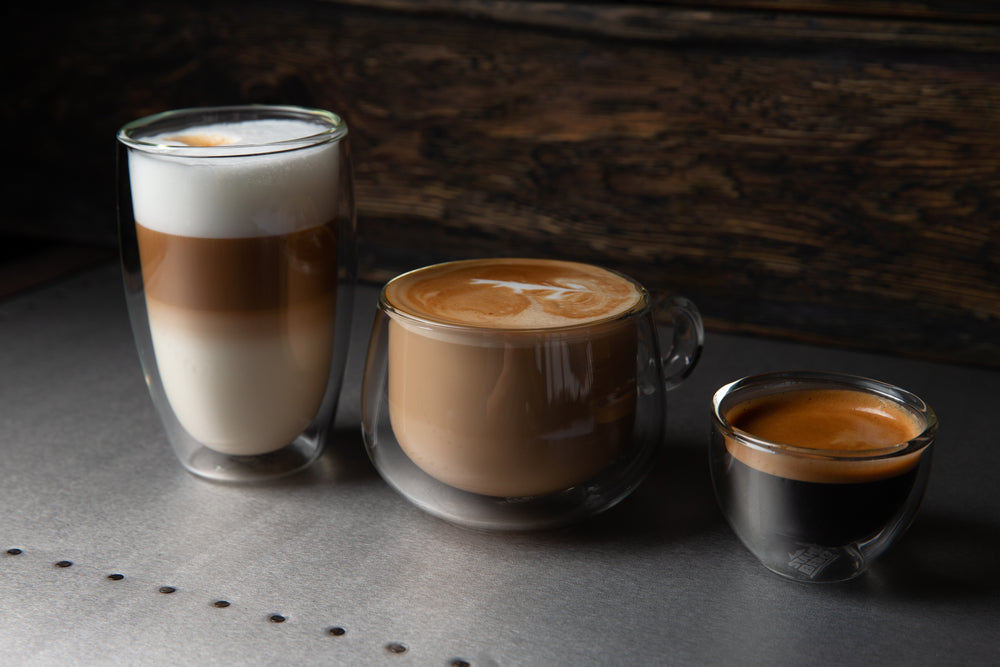Add description, images, menus and links to your mega menu
A column with no settings can be used as a spacer
Link to your collections, sales and even external links
Add up to five columns
Add description, images, menus and links to your mega menu
A column with no settings can be used as a spacer
Link to your collections, sales and even external links
Add up to five columns

How to Make Espresso at Home
September 26, 2017 3 min read
How to Make Espresso at Home: The Ultimate Guide
What is Espresso?
Espresso is a richly flavored, highly concentrated form of coffee brewed by forcing nearly boiling water through finely-ground coffee beans under high pressure. This process results in a thicker, more intense coffee that is typically served in small, one-ounce shots in demitasse cups. Achieving the perfect espresso requires attention to several crucial variables and the right equipment.
Essential Variables for Perfect Espresso
Water Quality
The quality of your water significantly affects the taste of your espresso. Use a water test kit to check for unwanted minerals, scale, and sediments, or contact your local water supplier for information on water quality. Filtered or bottled water often produces the best results.
Coffee Dose
The standard dose for a double-shot of espresso ranges between 18 and 21 grams of coffee. Adjusting the dose allows you to customize the intensity and concentration of your espresso. Experiment to find your preferred taste.
Yield
For the perfect espresso pull, balance the coffee input with the beverage output. Aim for about two ounces of espresso, or approximately 30 grams, to achieve the ideal yield. This will fill a standard shot glass and provide a rich, flavorful experience.
Coffee Grind
A fine grind is essential for making espresso. The finer the grind, the more surface area is available for extraction, resulting in a more intense flavor. Aim for a grind consistency similar to talcum powder. However, be cautious not to grind too fine, as this can lead to over-extraction and bitterness.
Tamping
Even extraction requires proper tamping. Use a tamper to compact the coffee grind firmly and levelly. This ensures that water flows evenly through the coffee, producing a balanced and flavorful shot.
Temperature
The ideal brewing temperature for espresso ranges between 195-205°F. Some espresso machines allow you to control this temperature, which can affect the solubility of caffeine and acids, impacting the final taste.
Extraction Time
Timing is crucial for espresso extraction. Aim for a single 40ml shot to pass through the coffee grind in 20-30 seconds. This balance ensures optimal flavor extraction without over-extraction, which can lead to bitterness.
By paying close attention to these variables and using quality equipment, you can master the art of making espresso at home. Enjoy experimenting with different doses, grinds, and extraction times to find your perfect cup of espresso.

How to Make Espresso at Home—Essential Equipment
Espresso Machine
The cornerstone of making exceptional espresso at home is the espresso machine. When choosing the best espresso machine, look for one with stable temperature control, robust components, and a user-friendly interface. Reliable temperature stability is crucial for consistent extraction, while solid construction ensures durability and performance.
Coffee Grinder
A high-quality coffee grinder is vital for grinding your coffee beans to the perfect consistency. For the best results, opt for a burr coffee grinder over a blade grinder. Burr grinders produce fine, uniform coffee particles and offer multiple adjustment settings, which are essential for achieving the ideal grind for espresso.
Filter
Most espresso machines come with a built-in filter. Start with a two-spout portafilter and insert a double basket. This setup allows for even extraction and optimal flavor.
Tamper
While many espresso machines come with a plastic tamper, upgrading to a high-quality tamper can significantly improve your espresso shots. Choose a tamper made of stainless steel with a comfortable handle that fits your portafilter basket perfectly. This ensures even distribution and pressure, resulting in a better extraction.
Scale
Using a precise gram scale helps you monitor and maintain consistency in your espresso making. Scales with low resolutions of about 0.1 to 1-gram increments are ideal for accurately measuring coffee doses and ensuring consistent results. A scale also helps identify and troubleshoot any issues in your brewing process.
Vessel
A shot glass with volumetric markings is useful for catching your espresso and measuring the output. This is especially handy if you don't have a scale. Knowing the volume of your espresso shot helps you fine-tune your extraction process for the perfect brew.
By equipping yourself with these essential tools and paying attention to the details, you can create high-quality, consistently delicious espresso shots and drinks at home. Follow these guidelines, ensure your equipment is in top condition, and enjoy the satisfaction of being your own barista.
How to Make Espresso at Home Part 2
Espresso Coffee and 6 Espresso Coffee Drink Recipes
Subscribe
Sign up to get the latest on sales, new releases and more …
